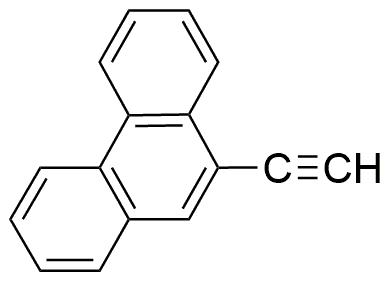9-Ethynylphenanthrene is widely utilized in research focused on:
- Organic Electronics: This compound is used in the development of organic light-emitting diodes (OLEDs) and organic photovoltaics, enhancing energy efficiency and performance.
- Material Science: It serves as a building block for creating advanced materials with tailored properties, such as improved thermal stability and mechanical strength.
- Fluorescent Probes: Researchers utilize it as a fluorescent probe in biochemical assays, allowing for the detection of specific biomolecules with high sensitivity.
- Polymer Chemistry: It is incorporated into polymer matrices to modify their optical and electronic properties, making them suitable for various applications in coatings and films.
- Pharmaceutical Research: The compound is explored for its potential in drug development, particularly in creating novel therapeutic agents with unique mechanisms of action.
General Information
Properties
Safety and Regulations
Applications
9-Ethynylphenanthrene is widely utilized in research focused on:
- Organic Electronics: This compound is used in the development of organic light-emitting diodes (OLEDs) and organic photovoltaics, enhancing energy efficiency and performance.
- Material Science: It serves as a building block for creating advanced materials with tailored properties, such as improved thermal stability and mechanical strength.
- Fluorescent Probes: Researchers utilize it as a fluorescent probe in biochemical assays, allowing for the detection of specific biomolecules with high sensitivity.
- Polymer Chemistry: It is incorporated into polymer matrices to modify their optical and electronic properties, making them suitable for various applications in coatings and films.
- Pharmaceutical Research: The compound is explored for its potential in drug development, particularly in creating novel therapeutic agents with unique mechanisms of action.
Documents
Safety Data Sheets (SDS)
The SDS provides comprehensive safety information on handling, storage, and disposal of the product.
Product Specification (PS)
The PS provides a comprehensive breakdown of the product’s properties, including chemical composition, physical state, purity, and storage requirements. It also details acceptable quality ranges and the product's intended applications.
Certificates of Analysis (COA)
Search for Certificates of Analysis (COA) by entering the products Lot Number. Lot and Batch Numbers can be found on a product’s label following the words ‘Lot’ or ‘Batch’.
Número de catálogo
Número de lote/lote
Certificates Of Origin (COO)
This COO confirms the country where the product was manufactured, and also details the materials and components used in it and whether it is derived from natural, synthetic, or other specific sources. This certificate may be required for customs, trade, and regulatory compliance.
Número de catálogo
Número de lote/lote
Safety Data Sheets (SDS)
The SDS provides comprehensive safety information on handling, storage, and disposal of the product.
DownloadProduct Specification (PS)
The PS provides a comprehensive breakdown of the product’s properties, including chemical composition, physical state, purity, and storage requirements. It also details acceptable quality ranges and the product's intended applications.
DownloadCertificates of Analysis (COA)
Search for Certificates of Analysis (COA) by entering the products Lot Number. Lot and Batch Numbers can be found on a product’s label following the words ‘Lot’ or ‘Batch’.
Número de catálogo
Número de lote/lote
Certificates Of Origin (COO)
This COO confirms the country where the product was manufactured, and also details the materials and components used in it and whether it is derived from natural, synthetic, or other specific sources. This certificate may be required for customs, trade, and regulatory compliance.


